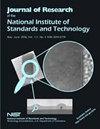NIST弹道学工具标记研究数据库
IF 1.3
4区 工程技术
Q3 INSTRUMENTS & INSTRUMENTATION
Journal of Research of the National Institute of Standards and Technology
Pub Date : 2020-01-20
DOI:10.6028/jres.125.004
引用次数: 6
摘要
2009年,美国国家科学院(National Academies)的一份报告对枪支检查人员视觉工具标记识别的客观性提出了质疑。美国国家科学院建议制定客观的工具标记识别标准和错误率估计。工业界、学术界和政府实验室正在寻求实现这一目标的两种有希望的方法:1)开发数学标准和先进的算法,用于客观和自动识别潜在匹配并评分;2)用三维表面形貌测量数据补充传统的反射显微镜图像。由于缺乏对工具标记数据集的访问,这两种客观工具标记识别方法的开发和验证受到阻碍,这些数据集1)代表了工具标记检验员遇到的各种各样的弹道工具标记,2)代表了具有挑战性的识别场景,例如连续制造的火器部件所构成的场景。NIST弹道学工具标记研究数据库使研究人员能够测试和验证客观的、基于数学的工具标记识别的新方法,同时简化向三维表面形貌数据的过渡。该数据库将为建立一个科学知识库奠定基础,以了解不同枪支所制造的痕迹之间的相似程度以及单个枪支所制造的痕迹的可变性。目前相当有限的知识库是制定和验证适用于各种火器和弹药品牌的客观数学相似标准和相关置信限的根本障碍。本文章由计算机程序翻译,如有差异,请以英文原文为准。
NIST Ballistics Toolmark Research Database
In 2009, a report by the National Academies called into question, amongst other
issues, the objectivity of visual toolmark identification by firearms examiners. The
National Academies recommended development of objective toolmark identification criteria
and error rate estimates. Industry, academia, and government laboratories are pursuing
two promising approaches towards this goal: 1) development of mathematical criteria and
advanced algorithms for the objective and automated identification and scoring of
potential matches, and 2) supplementing traditional reflectance microscopy images with
three- dimensional surface topography measurement data. Development and validation of
both these approaches to objective toolmark identification are hindered by a lack of
access to toolmark data sets that 1) represent the large variety of ballistic toolmarks
encountered by toolmark examiners, and 2) represent challenging identification
scenarios, such as those posed by consecutively manufactured firearms components. The
NIST Ballistics Toolmark Research Database enables researchers to test and validate new
approaches to objective, mathematics-based, toolmark identification while easing the
transition to three- dimensional surface topography data. The database will provide a
foundation for a scientific knowledge base on the degree of similarity that can be found
between marks made by different firearms and the variability in marks made by an
individual firearm. The current, fairly limited, knowledge base is a fundamental barrier
to the development and validation of objective mathematical similarity criteria, and
associated confidence limits, applicable to a broad range of firearms and ammunition
brands.
求助全文
通过发布文献求助,成功后即可免费获取论文全文。
去求助
来源期刊
自引率
33.30%
发文量
10
审稿时长
>12 weeks
期刊介绍:
The Journal of Research of the National Institute of Standards and Technology is the flagship publication of the National Institute of Standards and Technology. It has been published under various titles and forms since 1904, with its roots as Scientific Papers issued as the Bulletin of the Bureau of Standards.
In 1928, the Scientific Papers were combined with Technologic Papers, which reported results of investigations of material and methods of testing. This new publication was titled the Bureau of Standards Journal of Research.
The Journal of Research of NIST reports NIST research and development in metrology and related fields of physical science, engineering, applied mathematics, statistics, biotechnology, information technology.

 求助内容:
求助内容: 应助结果提醒方式:
应助结果提醒方式:


